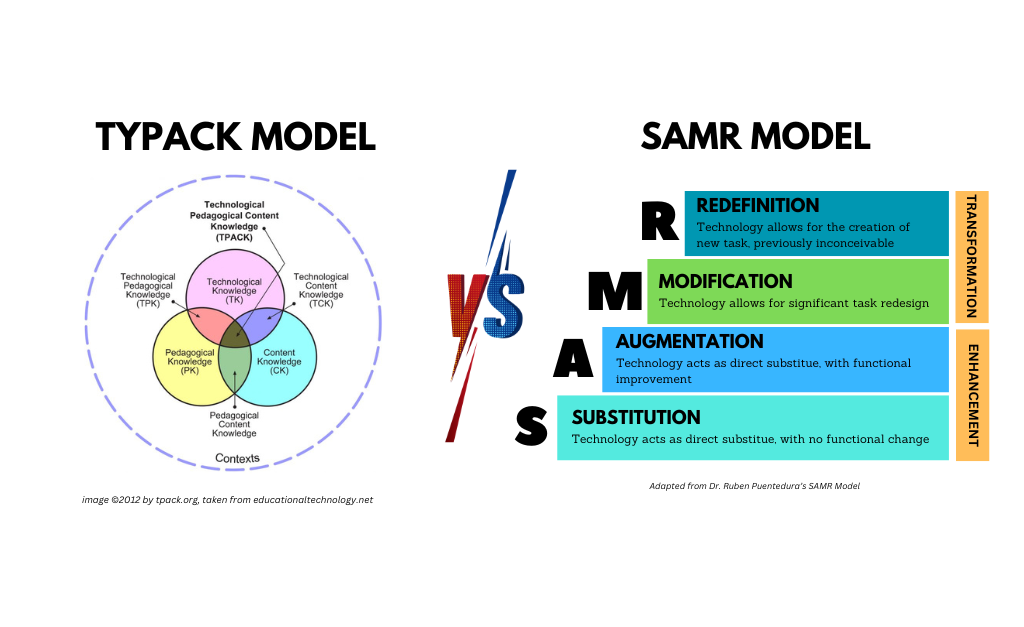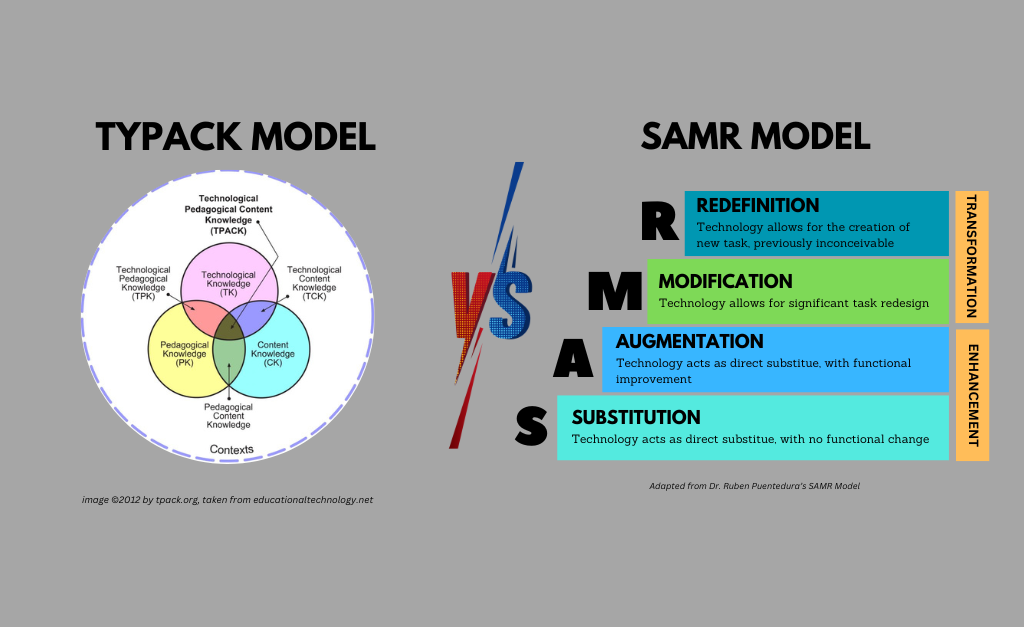Technology has entered every aspect of our lives, including education. Educators have been looking for methods to incorporate technology into their lessons to boost learner engagement and learning results since the emergence of digital technologies.
TPACK and SAMR are two common models or frameworks for integrating technology into education. In this article, we will compare these two models and consider their advantages and disadvantages.
Introduction
Technology integration in education involves utilising numerous digital tools and technologies to improve teaching and learning. Laptops, tablets, interactive whiteboards, educational software, and internet resources are examples of these technologies.
Technology integration enables engaging and dynamic learning experiences, access to a greater choice of materials, and supports individualised instruction to suit the needs of all learners.
TPACK (Technological Pedagogical Content Knowledge) and SAMR (Substitution, Augmentation, Modification, and Redefinition) models were introduced to integrate technology into education.
TPACK proposes that effective technology integration requires integrating three types of knowledge – technological, pedagogical, and content knowledge.
SAMR, on the other hand, is a framework for analysing the extent of technology integration in the classroom, with four levels: substitution, augmentation, modification, and redefinition.
Educators can evaluate the current level of technology integration in their classroom and identify areas for development by comparing TPACK and SAMR. They can also assess which model corresponds best with their teaching style and the learning needs of their learners.
Understanding the similarities and differences between these approaches will assist educators in making educated decisions about how to integrate technology to improve teaching and learning.
Comparison of TPACK and SAMR

TPACK and SAMR models are two popular frameworks that can help educators integrate technology effectively in the classroom. Let’s look at TPACK and SAMR, their similarities, differences, and strengths and limitations.
Similarities between TPACK and SAMR
TPACK and SAMR share similarities in their approach to technology integration in education. Here are some of the key similarities between the two models:
- Improve teaching and learning: TPACK and SAMR are both intended to improve teaching and to learn through effective technology integration.
- Incorporate multiple factors: Both approaches consider multiple factors when integrating technology in education.
- Encourage a learner-centred approach: Both models encourage a learner-centred approach to learning by supporting technology to enable individualised education and cater to each learner’s needs.
- Offer a framework for technology integration: TPACK and SAMR provide educators with a framework for integrating technology in education and instruction on how to use technology effectively in the classroom.
Differences between TPACK and SAMR
Although TPACK and SAMR have certain similarities, they also have some significant differences. Here are some of the main differences:
- TPACK emphasises the integration of technological, pedagogical, and content knowledge, whereas SAMR categorises technology integration into four levels (substitution, augmentation, modification, and redefinition).
- TPACK is a more comprehensive model that provides a holistic framework for technology integration, whereas SAMR primarily focuses on analysing the extent of technology integration in a particular activity.
- TPACK emphasises the relevance of educators’ knowledge and competence in effectively integrating technology, whereas SAMR emphasises designing activities that use technology to assist learning.
- TPACK is more adaptable, allowing for diverse approaches to technology integration, whereas SAMR provides a prescriptive framework that advises how to integrate technology step by step.
Strengths and Limitations of TPACK and SAMR
TPACK recognise the relationship between technology, pedagogy, and content knowledge. Educators can create more effective and meaningful technology integration. However, one of the limitations of TPACK is that it may be too abstract for some educators to apply in practice.
Meanwhile, SAMR helps educators assess their level of technology integration into the classroom and helps identify areas for improvement. However, one of the limitations of SAMR is that it may oversimplify the complex relationship between technology, pedagogy, and content.
Read more: SAMR Model: A Complete Guide for k-12 Classroom Technology Integration
Applications of TPACK and SAMR
The TPACK and SAMR models provide educators with frameworks for integrating technology into their teaching practices. Educators can create engaging and effective learning environments by understanding these models and applying them in the classroom.
Use of TPACK and SAMR in Education
TPACK is a model that helps educators design lessons that effectively integrate technology. It highlights the significance of combining technical, pedagogical, and content expertise for developing effective lessons.
SAMR, on the other hand, is a model used to assess the extent of technology integration in the classroom. It divides technology integration into four stages: substitution, augmentation, modification, and redefinition, and encourages educators to go to higher degrees.
Educators that use TPACK will think about which technological tools they can use to support student learning and how these technologies may be integrated into the session to make it more engaging and interactive.
Teachers who utilise SAMR, on the other hand, will assess how successfully they are utilising technology, as well as if they are just substituting old tools or altering the way teaching and learning occur.
Examples of TPACK and SAMR in Practice
In this section, we will look at examples of the TPACK and SAMR models used in real-world educational settings. These examples will better understand how these models can be utilised to improve teaching and learning by successfully incorporating technology.
TPACK in Practice
TPACK in practice will demonstrate the seamless integration of technological, pedagogical, and content knowledge. Here are some examples of TPACK in practice:
- The use of an interactive whiteboard and online resources to teach a lesson on the geography and culture of different countries.
- The use of wearable fitness trackers to monitor and analyse students’ physical activity levels during class.
- The use of an online discussion forum and literary analysis software to facilitate class discussions and evaluate student understanding of assigned texts.
- The use of a digital audio workstation and software to teach music composition and production.
- The use of a language learning app and augmented reality to simulate real-world language use scenarios.
SAMR in Practice
SAMR in practice will analyse the extent of technology integration in the classroom. Here are some examples of SAMR in practice:
- The use of a 3D printer to create models of molecules for students to examine, showing the substitution level of technology integration.
- The use of an online game allows students to play individually, in pairs, or small groups, showing the augmentation level of technology integration.
- The use of an online museum exhibit demonstrating the modification level of technology integration.
- The use of a digital writing project that integrates multimedia elements and uses peer review tools, showing the redefinition level of technology integration.
- The use of virtual reality to create immersive learning experiences in social studies class, allowing students to travel back in time and experience historical events, demonstrating the redefinition level of technology integration.
Read More: TPACK Model: Framework Explanations, Components, Best Practices and Examples
Advantages and Challenges of TPACK and SAMR Applications
The TPACK and SAMR models provide a framework for integrating technology into education, but their use also presents advantages and challenges. Let’s see the advantages and challenges of applying these models in educational settings.
Advantages of TPACK and SAMR Applications
- Increased Student Engagement: The effective use of TPACK and SAMR models can lead to increased student engagement and motivation as technology can help to make learning more interactive and personalised.
- Improved Learning Outcomes: By integrating technology effectively, teachers can help students to understand complex concepts better, increase their critical thinking skills, and enhance their problem-solving abilities.
- Access to a Wider Range of Resources: TPACK and SAMR applications provide access to a broader range of educational resources that can support teaching and learning in ways that were not possible before.
- Better Collaboration: Technology integration through TPACK and SAMR can improve collaboration between students, as well as between students and teachers, leading to a more connected and interactive learning environment.
Challenges of TPACK and SAMR Applications
- Cost: Implementing TPACK and SAMR applications can be expensive, and schools may not have the resources to provide technology for all students, leading to a digital divide.
- Teacher Training: Effective technology integration requires proper teacher training, which can be time-consuming and costly for schools.
- Technology Dependence: Overreliance on technology can lead to reduced critical thinking skills, and students may struggle when they do not have access to technology.
- Resistance to Change: Teachers and students may resist change, making implementing new technology integration strategies challenging.
Read more: 10 Fun and Effective Learning Games to Gamify Your Online Classroom
Conclusion
In conclusion, while TPACK and SAMR have different approaches to technology integration in education, they aim to improve student learning outcomes. Both models have strengths and limitations, and their applications have advantages and challenges.
The main advantage of TPACK is that it emphasises the importance of understanding how technology can be used to enhance pedagogical practices and improve student learning. SAMR, on the other hand, provides a clear framework for evaluating the level of technology integration in the classroom.
Despite their differences, TPACK and SAMR both play vital roles in education. Teachers may use TPACK to create more exciting and successful classes, while SAMR can help them analyse and improve their technology integration strategies.
Educators must understand TPACK and SAMR for effective technology integration in their classrooms. These models can assist teachers in enhancing their education methods, involving students in practical learning, and ensuring their success in the digital age.
Leveraging Generative AI, HeyHi empower educators to:
- Boost assessment efficiency with our question and assessment generator.
- Craft personalised lesson modules in e-book and videos with ease.
- Give 24/7 support for all students with our AI Learning Buddy.
- Create unique learning journeys for each student, maximising their potential.
- And many more!
Start a new chapter of revolutionised teaching with HeyHi. Let us know how we can help you best by contacting us today.
About HeyHi
HeyHi empowers schools and education institutions to enable personalised adaptive learning with a robust AI-powered e-assessment and learning system. We allow schools to offer holistic education, encompassing both foundational academic learning and 21st Century Competencies development. Create adaptive worksheets and lesson modules, automate grading, track performance & identify learning gaps, all with just a few clicks. Accelerate students’ learning with 24/7 adaptive feedback from our AI Learning Buddy. Flexible content options and seamless integration ensure efficiency, saving you valuable hours and costs.
Website: heyhi.sg
LinkedIn: linkedin.com/company/heyhilearningspace/
Facebook: facebook.com/HeyHiLearningSpace
Instagram: instagram.com/heyhilearningspace/
